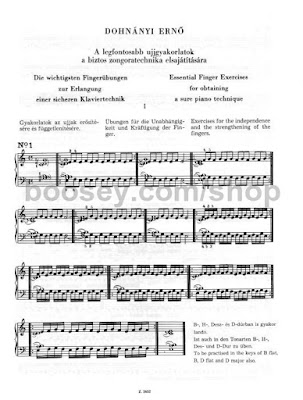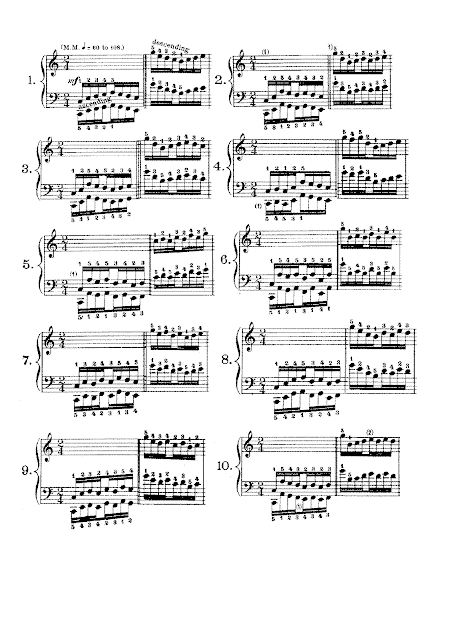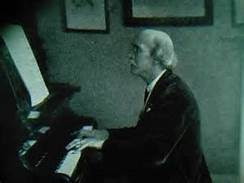Here is a repost of one of the most popular posts:
In a forum for pianists, a physical therapist remarked that one of her clients, a doctor, had
been advised to stop playing the piano because of painful arthritis. There ensued much discussion about whether or not piano playing causes, exacerbates or alleviates symptoms. My advice in these circumstances is—keeping in mind that I am not a medical doctor—first get a thorough evaluation from medical experts. After that, proceed gently using methods that do not interfere with the body’s natural design.
My response to the poster was: Your client should find a teacher who understands how the
playing mechanism works. In brief: The fingers do not act by lifting away from the hand, but rather operate as a connected unit with the hand and forearm, through a forearm rotation. This particular action is a natural, quick and easy one and has proven to be therapeutic. It's not possible to play the piano without it; trying to thwart it causes injury. There is a series of DVDs published by the Dorothy Taubman Institute that might be a good starting point. Avoid at all costs exercises by Czerny, Hanon and the others. They are at best a waste of time and at worst can create a misunderstanding of what is needed to play.
One possible approach for this pianist would be to explore how the forearm works. She could try this: Lift the arm up from the elbow and notice the
hand is in a karate-chop position with the heel of your hand facing the keys. In order to play at all we have to turn (rotate) the forearm toward the thumb. When this movement is not understood, it is possible that unnecessary tension will exacerbate the arthritis symptoms. This rotation gets the forearm behind the finger that is playing and is the source of power and speed. But it is only a tool. We move laterally up and down the keys using other mechanisms which I don't have time to describe here. We play the piano with our fingers in alignment with the wrist hand and arm. Also, it is a mistake to think of originating a movement from the wrist because then the fingers, more often than not, turn to wet noodles.
It was suggested that she study Czerny and Hanon, which many people use with enthusiasm—even today in the face of what we now know. My feeling is that if you know how to play them technically, then you don't need them. Their premise is that we train for endurance and physical strength similar to the way weight-lifters train. This is a fallacy. We train refined muscles for coordination. A small child is "strong" enough to play the piano. Repetition training of the sort advocated by the authors of these exercises falls too easily into the category of mindless rote.
I think it's more important to examine how this arthritic pianist moves at the keyboard, rather than the issue of what repertoire to play. In general, though, she may want to take care not to extend
her hands to extremes. That is, avoid stretched intervals, particularly octave positions with a minor second in the index finger. And of course, if something causes discomfort, don't do it. Since she's a doctor, she may have an advantage.
Some pianists argue that they don't use forearm rotation, so I repeat: Lift your forearm up from where it hangs at your side. Lift from the elbow. Do nothing else. Your hand will not be in a playing position. In order to be in a playing position you must rotate your forearm in the elbow axle toward the thumb. This is the first example of forearm rotation as an UNDERLYING TOOL. It is only one of many refinements we use. It is not the only way to play the piano. But you can't play without it. Moreover, understanding forearm rotation as an underlying tool contributes to an efficient and fluent technique.
In all fairness, I think I understand where the rotation doubters come from. They can see applications in Alberti figures because that’s rather obvious. If they play naturally and with ease and if they had facility at an early age, it is difficult for them to understand what is underneath and why it's important for people with less natural facility to discover for themselves what works.
I also can understand why they might think movements originate from the wrist. In a well-coordinated technique in which lateral movements are incorporated—walking arm and shaping—the wrist moves in ovate gestures, giving the appearance of being the motor behind the fingers. The piano is played with the fingers in collaboration with the wrist. It is not useful to think of initiating the movement from the wrist,
but rather allowing the wrist to participate. This takes some deliberation. And unless a pianist is willing to give it thought, the understanding will never come.
So I say to pianists faced with arthritic pain, find ways to use the playing mechanism in the manner to which it was born. That is, use it according to its design. Never mind the rotation doubters. It’s possible to make music at the piano from many different points of view, or from no point of view at all, the latter approach being the most common. I choose to make use of knowledge. If the choice is between ease or difficulty, I choose ease. This knowledge can be therapeutic.
In a forum for pianists, a physical therapist remarked that one of her clients, a doctor, had
been advised to stop playing the piano because of painful arthritis. There ensued much discussion about whether or not piano playing causes, exacerbates or alleviates symptoms. My advice in these circumstances is—keeping in mind that I am not a medical doctor—first get a thorough evaluation from medical experts. After that, proceed gently using methods that do not interfere with the body’s natural design.
My response to the poster was: Your client should find a teacher who understands how the
playing mechanism works. In brief: The fingers do not act by lifting away from the hand, but rather operate as a connected unit with the hand and forearm, through a forearm rotation. This particular action is a natural, quick and easy one and has proven to be therapeutic. It's not possible to play the piano without it; trying to thwart it causes injury. There is a series of DVDs published by the Dorothy Taubman Institute that might be a good starting point. Avoid at all costs exercises by Czerny, Hanon and the others. They are at best a waste of time and at worst can create a misunderstanding of what is needed to play.
One possible approach for this pianist would be to explore how the forearm works. She could try this: Lift the arm up from the elbow and notice the
hand is in a karate-chop position with the heel of your hand facing the keys. In order to play at all we have to turn (rotate) the forearm toward the thumb. When this movement is not understood, it is possible that unnecessary tension will exacerbate the arthritis symptoms. This rotation gets the forearm behind the finger that is playing and is the source of power and speed. But it is only a tool. We move laterally up and down the keys using other mechanisms which I don't have time to describe here. We play the piano with our fingers in alignment with the wrist hand and arm. Also, it is a mistake to think of originating a movement from the wrist because then the fingers, more often than not, turn to wet noodles.
It was suggested that she study Czerny and Hanon, which many people use with enthusiasm—even today in the face of what we now know. My feeling is that if you know how to play them technically, then you don't need them. Their premise is that we train for endurance and physical strength similar to the way weight-lifters train. This is a fallacy. We train refined muscles for coordination. A small child is "strong" enough to play the piano. Repetition training of the sort advocated by the authors of these exercises falls too easily into the category of mindless rote.
I think it's more important to examine how this arthritic pianist moves at the keyboard, rather than the issue of what repertoire to play. In general, though, she may want to take care not to extend
her hands to extremes. That is, avoid stretched intervals, particularly octave positions with a minor second in the index finger. And of course, if something causes discomfort, don't do it. Since she's a doctor, she may have an advantage.
Some pianists argue that they don't use forearm rotation, so I repeat: Lift your forearm up from where it hangs at your side. Lift from the elbow. Do nothing else. Your hand will not be in a playing position. In order to be in a playing position you must rotate your forearm in the elbow axle toward the thumb. This is the first example of forearm rotation as an UNDERLYING TOOL. It is only one of many refinements we use. It is not the only way to play the piano. But you can't play without it. Moreover, understanding forearm rotation as an underlying tool contributes to an efficient and fluent technique.
In all fairness, I think I understand where the rotation doubters come from. They can see applications in Alberti figures because that’s rather obvious. If they play naturally and with ease and if they had facility at an early age, it is difficult for them to understand what is underneath and why it's important for people with less natural facility to discover for themselves what works.
I also can understand why they might think movements originate from the wrist. In a well-coordinated technique in which lateral movements are incorporated—walking arm and shaping—the wrist moves in ovate gestures, giving the appearance of being the motor behind the fingers. The piano is played with the fingers in collaboration with the wrist. It is not useful to think of initiating the movement from the wrist,
but rather allowing the wrist to participate. This takes some deliberation. And unless a pianist is willing to give it thought, the understanding will never come.
So I say to pianists faced with arthritic pain, find ways to use the playing mechanism in the manner to which it was born. That is, use it according to its design. Never mind the rotation doubters. It’s possible to make music at the piano from many different points of view, or from no point of view at all, the latter approach being the most common. I choose to make use of knowledge. If the choice is between ease or difficulty, I choose ease. This knowledge can be therapeutic.






























